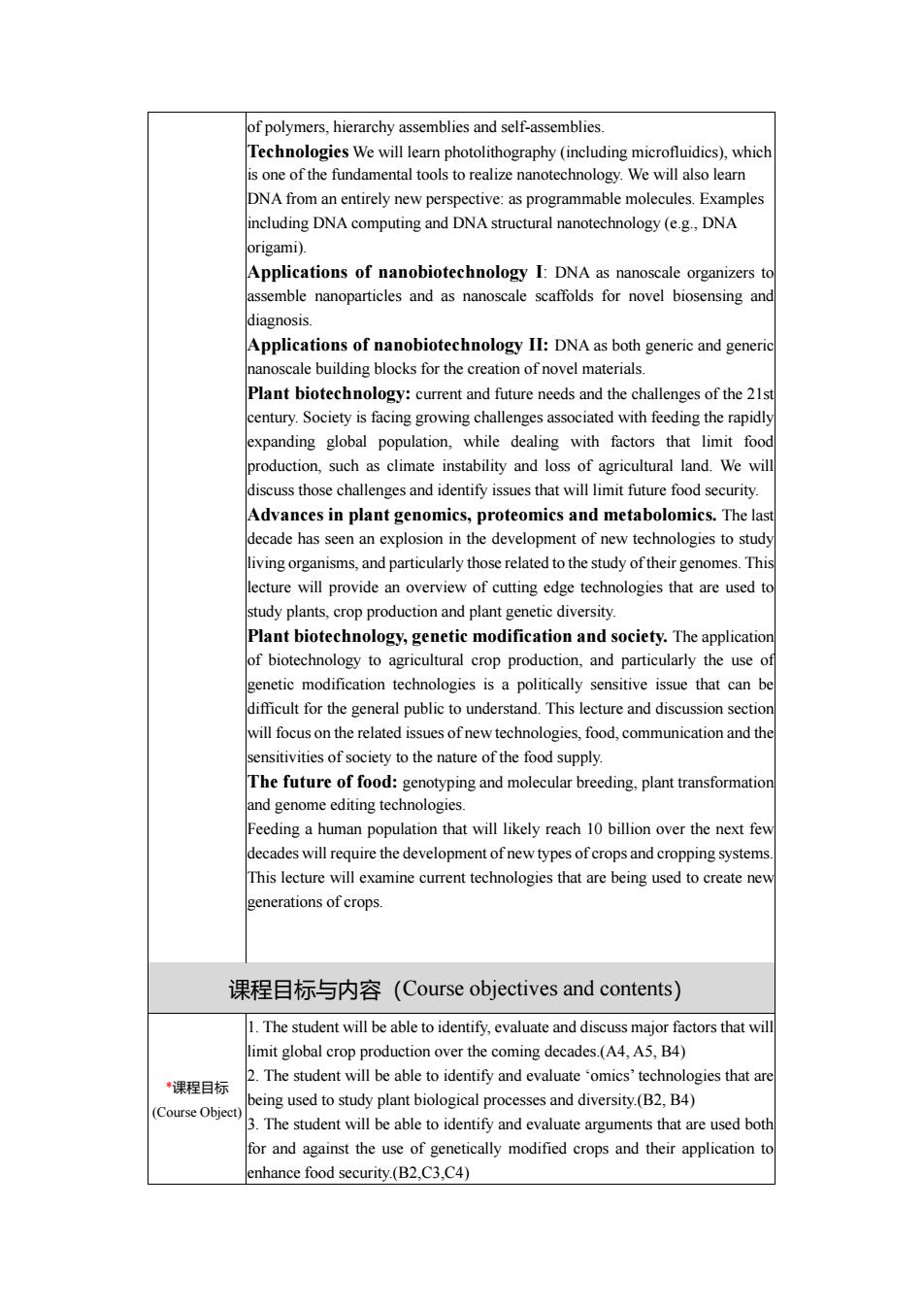正在加载图片...

of polymers,hierarchy assemblies and self-assemblies. Technol DNA from an entirely new perspective:as programmable molecules.Examples including DNA computing and DNA structural nanotechnology (e.g,DNA origami) Applications of nanobiotechnology I:DNA as nanoscale organizerst semble nanoparticles and as nanoscale scaffolds for novel biosensing anc diagnosis. Applications of nanobiotechnology II:DNA as both generic and generi nanoscale building blocks for the creation of novel materials. Plant:and future needs and the challenges of thes century.Society is facing growing challenges associated with feedin the rapid expanding global population,while dealing with factors that limit foo production,such as climate instability and loss of agricultural land.We will discuss those challenges and identify issues that will limit future food security. Advances in plant ge metabolomics.The ade has seen an expld on in the development of new hnologies to std living organisms,and particularly those related to the study of their genomes.Thi lecture will provide an overview of cutting edge technologies that are used to study plants,crop production and plant genetic diversity. Plant biotechnology,genetic modification and society.The applicatio of biotech crop production,and particulrly the use netic modification technologies is a politically sensitive issue that can b difficult for the general public to understand.This lecture and discussion sectior will focus on the related issues of new technologies,food,communication and the sensitivities of society to the nature of the food supply. and genome editing techr Feeding a human population that will likely reach 10 billion over the next fev decades will require the development of new types of crops and cropping systems This lecture will examine current technologies that are being used to create nev enerations of crops. 课程目标与内容(Course objectives and contents) limit global crop production over the coming decades.(A4,A5,B4) 2.The student will be able to identify and evaluate 'omics'technologies that are 课程目标 being used to study plant biological processes and diversitv.(B2.B4) (Course Obiect 3.The student will be able to identify and evaluate arguments that are used both for and against the use genetically modified ros and their application enhance food security.(B2.C3.C4)of polymers, hierarchy assemblies and self-assemblies. Technologies We will learn photolithography (including microfluidics), which is one of the fundamental tools to realize nanotechnology. We will also learn DNA from an entirely new perspective: as programmable molecules. Examples including DNA computing and DNA structural nanotechnology (e.g., DNA origami). Applications of nanobiotechnology I: DNA as nanoscale organizers to assemble nanoparticles and as nanoscale scaffolds for novel biosensing and diagnosis. Applications of nanobiotechnology II: DNA as both generic and generic nanoscale building blocks for the creation of novel materials. Plant biotechnology: current and future needs and the challenges of the 21st century. Society is facing growing challenges associated with feeding the rapidly expanding global population, while dealing with factors that limit food production, such as climate instability and loss of agricultural land. We will discuss those challenges and identify issues that will limit future food security. Advances in plant genomics, proteomics and metabolomics. The last decade has seen an explosion in the development of new technologies to study living organisms, and particularly those related to the study of their genomes. This lecture will provide an overview of cutting edge technologies that are used to study plants, crop production and plant genetic diversity. Plant biotechnology, genetic modification and society. The application of biotechnology to agricultural crop production, and particularly the use of genetic modification technologies is a politically sensitive issue that can be difficult for the general public to understand. This lecture and discussion section will focus on the related issues of new technologies, food, communication and the sensitivities of society to the nature of the food supply. The future of food: genotyping and molecular breeding, plant transformation and genome editing technologies. Feeding a human population that will likely reach 10 billion over the next few decades will require the development of new types of crops and cropping systems. This lecture will examine current technologies that are being used to create new generations of crops. 课程目标与内容(Course objectives and contents) *课程目标 (Course Object) 1. The student will be able to identify, evaluate and discuss major factors that will limit global crop production over the coming decades.(A4, A5, B4) 2. The student will be able to identify and evaluate ‘omics’ technologies that are being used to study plant biological processes and diversity.(B2, B4) 3. The student will be able to identify and evaluate arguments that are used both for and against the use of genetically modified crops and their application to enhance food security.(B2,C3,C4)